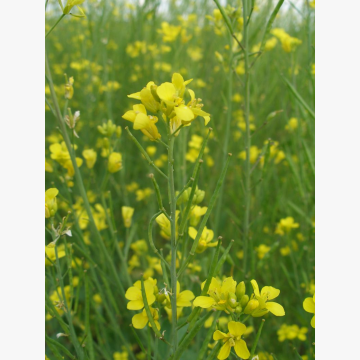- Home
- Seeds
- Oil / seasoning plants, etc.
- Brown mustard
- Brown mustard BRONS
FOR CONSULTATIONS APPLY TO:
Commercial director
Lina Smalskienė
tel. +370 618 02 551
e-mail linak@agrolitpa.lt
Sales manager
Tautvydas Kliučininkas
tel. +370 681 35 093
e-mail tautvydask@agrolitpa.lt
Sales manager
Eglė Petkevičienė
tel. +370 626 95 458
e-mail eglep@agrolitpa.lt
Sales manager
Kotryna Nakrošytė
tel.: +370 601 39 282
e-mail kotryna@agrolitpa.lt
Brown mustard BRONS
A late brown mustard with high green mass yield, very suitable for soil biofumigation, green manure
- Soil coverage speed – medium/fast
- Resistant to lodging
- Flowering – late
- Flowers – yellow
- Accumulates a lot of the glycoside sinigrin, so it is suitable for soil biofumification
- Effective against soil-dwelling pests and pathogens
- Can be sown in April-August
- When sown for green manure, it produces a crop in 50-70 days and benefits the soil
- When sowed in the second week of August, grows up to 80 cm, produces a lot of biomass
Benefits of using as green manure:
- Soil is enriched in organic matter
- Soil fertility and structure is improved
- Soil erosion is decreased
- Soil biodiversity is increased
- Ideal for both organic and conventional crop rotations
Recommended use for the best biofumigation effect:
- Pre-crop is harvested
- Soil is prepared for sowing
- Brown mustard is sown (as catch crop)
- Cultivated until flowering
- Biofumigation works best by incorporating chopped flowering plants into moist soil
- The most optimal term is the beginning of flowering + 10 days; the latest – the beginning of flowering +20 days
- After incorporation of mustard to the soil, at least 10-15 days must pass before sowing the following plants
- Speed of covering the soil – 4 points (out of 4) (very fast)
- Flowering time – 1 point (out of 4) (very late)
- Resistance to lodging – 1 point (out of 4) (resistant)
*(According to the data of the Bundessortenamt, Beschreibende Sortenliste 2023, p. 334)
The varietal parameters may differ from those indicated here when the testing circumstances differ from quondam
Recommended sowing rate: 100-120 plants/m² or 10-12 kg/ha
Recommended sowing rate when growing for green manure: 12-15 kg/ha
Keravos sreet. 17, Kerava,
LT-38 131 Panevėžys district, LITHUANIA
Enterprise's code 168598128
VAT code LT685981219
Tel. +370 615 11 315
E. mail info@agrolitpa.lt




.JPG)

